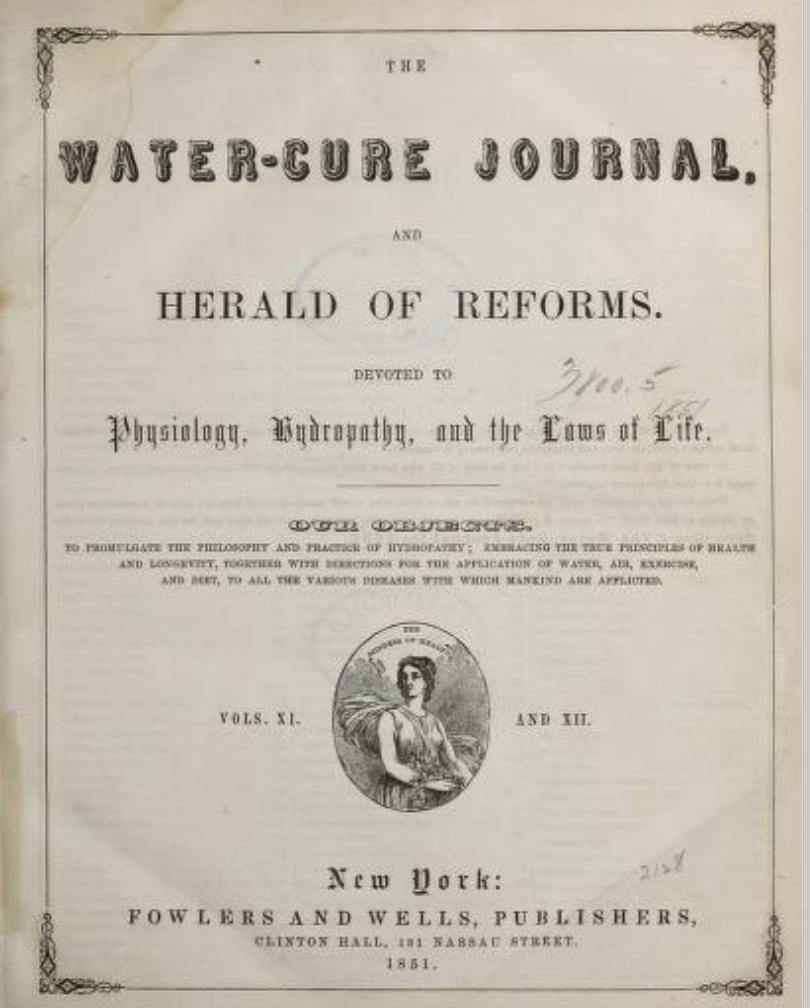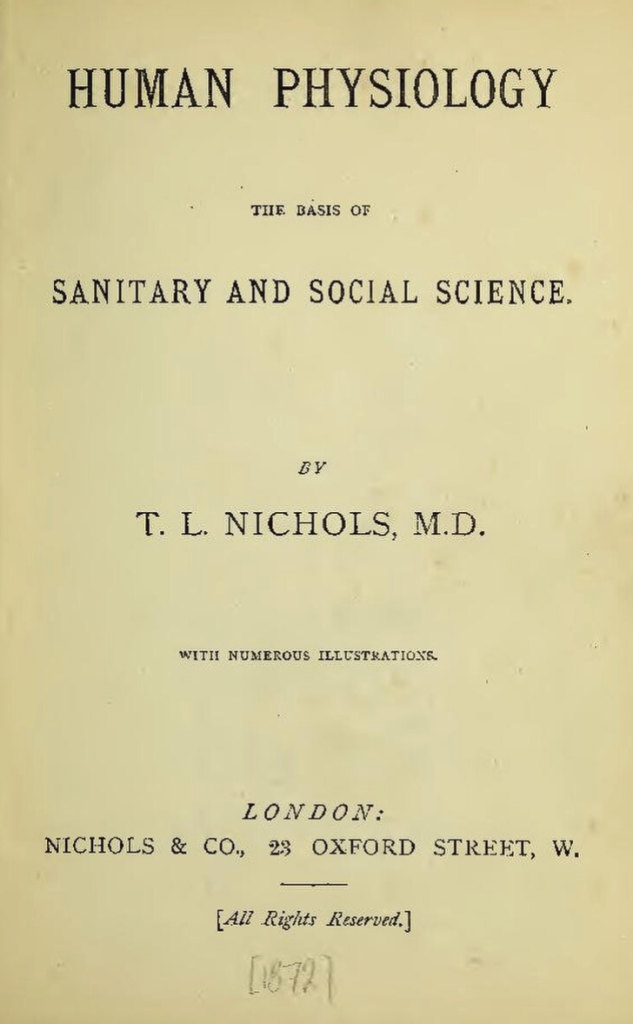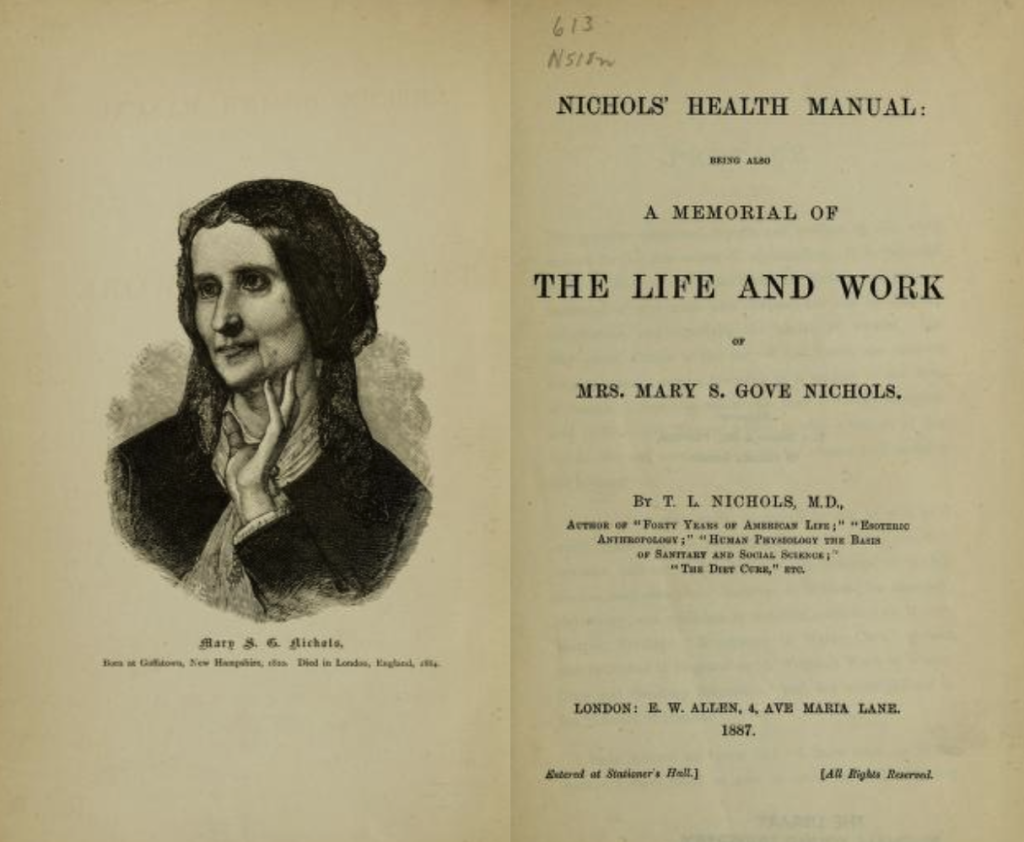1815: Thomas Nichols was born and raised in Orford, New Hampshire.
1834: At age 19, he began to study medicine at Dartmouth College. Thomas immediately followed his principles after hearing Sylvester Graham’s lecture in Boston. Grahamites, as they were called, limited their diets, had strict mealtimes, avoided meat, spices, and condiments, abstained from tea, coffee, or alcohol, breathed fresh air, and bathed regularly. He gave up the study of medicine and became a newspaperman, traveling over the West and South. Upon his return to New York, he took the position as editor of the New York Evening Herald. He was active in several movements, including women’s rights, and while in this work, he eventually met Mary Gove, who began to lecture on Grahamism.
1837: Thomas wrote for the Buffalo Commercial Advertiser and Bennett’s Herald. He helped establish The Buffalonian and, during this time, wrote an article about B. Rathbun. He published the facts which he knew about Rathbun. The public knew them to be accurate, and three successive attempts to indict him failed. The fourth time was successful. He was convicted and imprisoned. He wrote about his experience from the trial to his time in prison and wrote the book Journal in Jail, Kept During a Four Months’ Imprisonment for Libel.
1845: Thomas and Mary began The Water Cure Journal and Harold of Reforms to continue educating and teaching. These journals were devoted to physiology, hydropathy, and the Laws of Life and included articles about individual and social health, education, hydrotherapy, dress reform, and women’s rights. The journal continued after 1855 as the Hygienic Teacher and Water-Cure Journal.
1848: Thomas Low Nichols married Mary Gove on July 29. Thomas was a writer and editor deeply interested in health reform and progressive views of women’s rights. Together, they worked to promote health.
1850: Thomas and Mary’s daughter, Mary Wilhelmina Nichols, was born on November 5.
1850: Thomas graduated with high honors from New York University with a medical degree and began working alongside Mary. Thomas decided to switch careers and complete his medical studies to get a license to practice. He did this to protect his wife in her work, as women were not admitted to medical colleges or other schools of “healing. During this time, Thomas Nichols was a prolific writer and leading contributor to the Water-Cure Journal.
1850: Mary and Thomas had very different views on marriage than current views of the time and wrote Marriage: its History, Character, and Results. This work argued forcefully against traditional monogamy and favored freedom of affection in love relations. They argued not only for a woman’s right to say no to sex but for her right to say yes as well, even outside of marriage.
1851: On September 15, 1851, Thomas and Mary opened The American Hydropathic Institute (AHI) in New York City to educate men and women. The AHI was a medical school for instruction in all branches of a thorough medical education, including the principles and practices of Water Cure in acute or chronic disease, surgery, and obstetrics. The AHI was the first school of this type in America and the world’s first drugless college. Although called a hydropathic institute, its teachings were Hygienic.
- There was strong opposition to women being admitted into the medical profession. The Hygienic school was far ahead of other schools of thought as women were found to be the strongest champions of “woman’s rights” among the Hygienists. Indeed, hygienists played a leading role in all of the reform movements of the time. If ever a complete history of the nineteenth century is written, the part played by Hygienists in its progress will be prominent.
- Hydropathy was practiced by practically all Hygienists at that time, the only known exceptions being Isaac Jennings and William Alcott. Even Graham was misled by the claims of the hydropathic school. Hydropathy was also taught at Russell Thacker Trall’s College.
1852: Thomas and Mary moved to Port Chester, New York, to open a school for women. Mary published Experience in Water-Cure: a Familiar Exposition of the Principles and Results of Water Treatment in the Rure of Acute and Chronic Diseases. This book illustrated numerous cases in the author’s practice, with an explanation of water-cure processes, advice on diet and regimen, the treatment of female diseases, water treatment in childbirth, and the diseases of infancy.
1853: The Water Cure Journal and Harold of Reforms were other projects Thomas and Mary worked on. These journals were devoted to physiology, hydropathy, and the Laws of Life and included articles about individual and social health, education, hydrotherapy, and women’s rights. It also included articles about the water cure, hygiene, dietetics, and dress reform. July 1851. Stanford Collection—Vol 1-8. The journal continued after 1855 as the Hygienic Teacher and Water-Cure Journal.
1856: Mary and Thomas moved to Yellow Springs, Ohio, where they established another water-cure institute in 1856. They offered a home, a school, a vegetable diet, hydropathic treatments, a disciplined life, and association to men and women who desired freedom from the despotism of society. They wanted to begin an experiment in community living, creating a culture of free love. Thomas gave local lectures such as “Free Love: a Doctrine of Spiritualism.” These were not well received within the local community. The public was not ready for this. Their advocacy of free love alienated them from other reformers as well.
1860: Thomas writes the book Esperanza: My Journey Thither and What I Found There.
- In Nichols’ Monthly, he partially published an epistolary utopian story, which he infused with his beliefs about free love, universal suffrage, and libertarianism; it was later published in novel form as Esperanza: My Journey Thither and What I Found There.
- Esperanza signifies the land of Hope. Thomas was an advocate of free love, a supporter of universal suffrage (Feminism), and a libertarian. These points are central to the Utopia at the heart of this story.
- The story is written in a series of letters by a young gentleman from New York on a journey to the Far West. He wants to find a future home for himself and his intended. He reaches Esperanza (Utopia) and describes the members of society as living in great harmony and happiness. He describes them as being intimate in relation to love with others and then sharing the responsibility of offspring with more than one.
1861: When the Civil War broke out, Mary and Thomas left New York and sailed to England. They opposed war and would not support either side. Shortly after their arrival, they began writing for English journals. When the opportunity presented itself, they lectured on vegetarianism and the laws of health.
1867 – 1872: Dr. and Mrs. Nichols moved to Malvern, England, the site of James Gully’s hydropathy spa, and set up a clinic.
1872: Thomas wrote the Human Physiology, the Basis of Sanitary and Social Science. In this book, Dr. Nichols defines the views as to the cause of disease among the Hygienists. He points out that some regarded disease as the result of a diminution of the nervous power or vital force (Jennings and Gove), while another group held that the blood is life and the impurity in the blood is the cause of all disease action (Trall). Nichols himself, anticipating Tilden by several years, adds: “But good blood cannot be formed without sufficient vital or nervous power, and good blood is necessary to the healthy action of the brain and nervous system. Here is reciprocal action, each depending upon the other. Waste matter, retained in the human system, is a “materies morbid”, and there are many kinds of blood poisoning.”
1873: Thomas published How to Behave: a Manual of Manners and Morals. He discusses behavior. From clothing to etiquette on how to converse to dealing with family, friends, community, and much more. He believed that humankind could live together harmoniously if they understood what good behavior was.
1884: Mary Gove Nichols dies on May 30th. Thomas carried on the Herald of Health until 1886. He retired and occasionally lectured.
1887: After his beloved wife Mary died, Thomas summarized what he learned throughout his life and published Nichol’s Health Manual: Being Also a Memorial of the Life and Work of Mrs. Mary Gove Nichols. He intended it to be a handbook of health and a tribute to the woman he married and her life’s work, especially for women’s health. He begins with a memorial to Mary and then discusses social conditions, marriage, human physiology, disease in general (especially female diseases), diet, digestion, and treatment. Hydropathy was explained, and various hydropathic processes were discussed. Included were also chapters on pregnancy, birth, and raising children.
1890: Dr. Nichols retires and moves to France, dying at 85.





 SUBSCRIBE TODAY AND NEVER MISS AN UPDATE
SUBSCRIBE TODAY AND NEVER MISS AN UPDATE